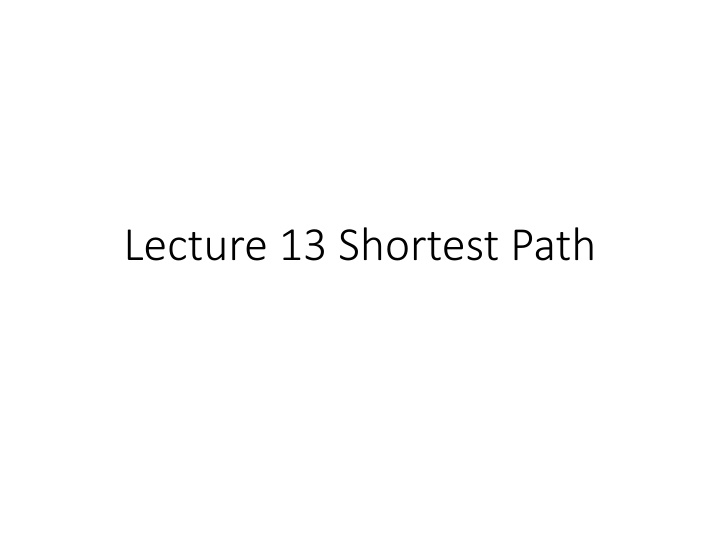
Understanding Shortest Path Algorithms in Graph Theory
Explore the concepts of shortest path algorithms in graph theory, starting from defining the problem to discussing Dijkstra's algorithm and its implementation. Discover the properties of shortest paths, dynamic programming approach, running time analysis, handling negative edge lengths, and more.
Download Presentation

Please find below an Image/Link to download the presentation.
The content on the website is provided AS IS for your information and personal use only. It may not be sold, licensed, or shared on other websites without obtaining consent from the author. If you encounter any issues during the download, it is possible that the publisher has removed the file from their server.
You are allowed to download the files provided on this website for personal or commercial use, subject to the condition that they are used lawfully. All files are the property of their respective owners.
The content on the website is provided AS IS for your information and personal use only. It may not be sold, licensed, or shared on other websites without obtaining consent from the author.
E N D
Presentation Transcript
Shortest Path problem Given a graph G, edges have length w(u,v) > 0. (distance, travel time, cost, ) Length of a path is equal to the sum of edge lengths Goal: Given source s and destination t, find the paths with minimum length.
Designing the algorithm What properties do shortest paths have? Claim: Given a shortest paths from s to t, any sub-path is still a shortest path between its two end-points. Which basic design technique has this property?
Shortest Path by Dynamic Programming ? ? = min ?,? ?? ?,? + ?(?) Length of last step Shortest Path to a Predecessor Problem: Graph may have cycle. What ordering do I use?
Dijkstras algorithm Main idea: The correct ordering is an ascending order of distance from source. Intuition: To get to a point v, if the last step of shortest path is (u, v), then u should always be closer to s than v. If I have computed shortest paths for all vertices that are closer to s than v, then I m ready to compute shortest paths to v.
Dijkstras algorithm Dijkstra(s) initialize dis[u] to be all infinity, prev[u] to be NULL For neighbors of s, initialize dis[u] = w[s,u], prev[u] = s Mark s as visited FOR i = 2 to n Among all vertices that are not visited, find the one with smallest distance, call it u. Mark u as visited FOR all edges (u,v) IF dis[u]+w[u,v] < dis[v] THEN dis[v] = dis[u]+w[u,v] prev[v] = u.
Running time To analyze the running time of a graph algorithm, usually we want to analyze what is the average amount of time spent on each edge/vertex For Dijkstra We need to find the closest vertex n times. We need to update weight of edges m times. Na ve implementation: O(n) per vertex, O(1) per edge Use a binary heap: O(log n) per vertex and edge. Best: Use Fibonacci heap, O(log n) per vertex, O(1) per edge. Total runtime = O(m + nlog n)
Shortest Path with negative edge length What is w(u,v) can be negative? Motivation: Arbitrage Image from wikipedia
Modeling arbitrage Suppose u, v are different currency, exchange rate is C(u,v) (1 unit of v is worth C(u,v) units of u) Let length of edge w(u,v) = log C(u,v) Length of a path = log of the total exchange rate Shortest path = best way to exchange money. Negative cycle = arbitrage.
How to compute shortest path with negative edges? Claim: Given a shortest paths from s to t, any sub-path is still a shortest path between its two end-points. Is this still true? Dijkstra: If I have computed shortest paths for all vertices that are closer to s than v, then I m ready to compute shortest paths to v. Is this still true?
Approach: dynamic programming with steps Bellman Ford algorithm: d[u, i] = length of shortest path to get to u with i steps ? ?,? + 1 = min ?,? ?? ?,? + ?(?,?) Shortest Path to a Predecessor Length of last step Question: How many steps do we need to take?
